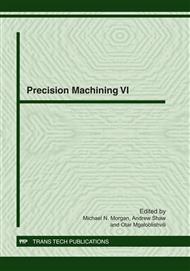[1]
P. Chavrier, A. Tidu, B. Bolle, P. Cesard and J.P. Tinnes: Investigation of Surface Integrity in High Speed End Milling of a Low Alloyed Steel. International Journal of Machine Tools & Manufacture (2003) volume 43, pp.1135-1142.
DOI: 10.1016/s0890-6955(03)00122-6
Google Scholar
[2]
C. R Liu, M.M., Barash: Variables Governing Patterns of Mechanical Residual Stress in a Machined Surface. Trans. ASME, Ser. B, 104 (1982), pp.257-264.
DOI: 10.1115/1.3185828
Google Scholar
[3]
J. Madl: Material Aspects of Chip Formation by Precision Machining. In ICPM-2003, Prague (2003), pp.42-49.
Google Scholar
[4]
M. Field, , J.F. Kahles: Review of Surface Integrity of Machined Components, Annals of the CIRP (1971), volume 20, no. 2, pp.153-163.
Google Scholar
[5]
J.D. Thiele, , S.N. Melkote, R.A. Peascoe and T.R. Watkins: Effect of Cutting Edge Geometry and Workpiece Hardness on Surface Residual Stresses in Finish Hard Turning of AISI 52100 Steel. Transaction of ASME (2000), volume 122, pp.642-649.
DOI: 10.1115/1.1286369
Google Scholar
[6]
M.C. Shaw, A. Vyas: Chip Formation in the Machining of Hardened Steel. Annals of the CIRP, volume 42 (1993), no. 1, pp.29-33.
DOI: 10.1016/s0007-8506(07)62385-3
Google Scholar
[7]
J. Madl, H. Sutanto: Surface Roughness og Hardened Steel in Precision Milling with Ceramic and Cubic Boron Nitride Cutting Tool. In Modern Metrology in Quality Management Systems, Kielce University of Technology, Kielce (2006), pp.111-118.
Google Scholar
[8]
M.A. Davies, Y. CHOU and, C.J. Evans: Tool Wear and Cutting Mechanics in Finish Hard Turning. Annals of the CIRP (1996), volume 45, no. 1, pp.77-82.
DOI: 10.1016/s0007-8506(07)63020-0
Google Scholar
[9]
H.A. Kishawi, M.A. Elbetsawi: Effects of Process Parameters on Chip Morphology when Machining Hardened Steels. Manufacturing Science and Technology, ASME Bound Volume, 1997, MED volume 6, no. 2, pp.13-20.
DOI: 10.1115/imece1997-1130
Google Scholar
[10]
Y.K. Chou, C.J. Evans and W.W. Barash: Experimental Investigation on Cubic Boron Nitride Turning of Hardened AISI 52100 Steel. Journal of Materials Processing Technology (2003), volume 134, pp.1-9.
DOI: 10.1016/s0924-0136(02)00070-5
Google Scholar
[11]
W. Konig, A. Berktold and K.F. Kock: Turning versus Grinding: A Comparison of Surface Integrity Aspects and Attainable Accuracies. Annals of the CIRP (1993), volume 42, no. 1, pp.39-43.
DOI: 10.1016/s0007-8506(07)62387-7
Google Scholar
[12]
W. Chen: Cutting Forces and Surface Finish when Machining Medium Hardness Steel using CBN Tools. International Journal of Machine Tools & Manufacture (2000), volume 40, pp.455-466.
DOI: 10.1016/s0890-6955(99)00011-5
Google Scholar
[13]
F. Holesovsky: Grinding Process and its Influence to Surface Integrity, In: AMPT´01, Madrid (2001) pp.587-596.
Google Scholar
[14]
H.A. Kishawi, M.A. Elbestawi: Effects of Edge Preparation and Cutting Speed on Surface Integrity of Die Materials in Hard Machining. International Journal of Machine Tools & Manufacture (1999), volume 39, pp.1017-1030.
DOI: 10.1115/imece1998-1038
Google Scholar


